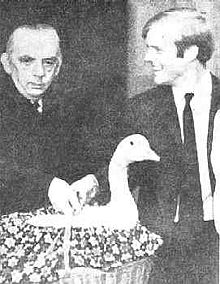
In mathematics, specifically functional analysis, a Banach space is said to have the approximation property (AP), if every compact operator is a limit of finite-rank operators. The converse is always true.
Every Hilbert space has this property. There are, however, Banach spaces which do not; Per Enflo published the first counterexample in a 1973 article. However, much work in this area was done by Grothendieck (1955).
Later many other counterexamples were found. The space of bounded operators on an infinite-dimensional Hilbert space does not have the approximation property. The spaces for and (see Sequence space) have closed subspaces that do not have the approximation property.
Definition
A locally convex topological vector space X is said to have the approximation property, if the identity map can be approximated, uniformly on precompact sets, by continuous linear maps of finite rank.
For a locally convex space X, the following are equivalent:
- X has the approximation property;
- the closure of in contains the identity map ;
- is dense in ;
- for every locally convex space Y, is dense in ;
- for every locally convex space Y, is dense in ;
where denotes the space of continuous linear operators from X to Y endowed with the topology of uniform convergence on pre-compact subsets of X.
If X is a Banach space this requirement becomes that for every compact set and every , there is an operator of finite rank so that , for every .
Related definitions
Some other flavours of the AP are studied:
Let be a Banach space and let . We say that X has the -approximation property (-AP), if, for every compact set and every , there is an operator of finite rank so that , for every , and .
A Banach space is said to have bounded approximation property (BAP), if it has the -AP for some .
A Banach space is said to have metric approximation property (MAP), if it is 1-AP.
A Banach space is said to have compact approximation property (CAP), if in the definition of AP an operator of finite rank is replaced with a compact operator.
Examples
- Every subspace of an arbitrary product of Hilbert spaces possesses the approximation property. In particular,
- every Hilbert space has the approximation property.
- every projective limit of Hilbert spaces, as well as any subspace of such a projective limit, possesses the approximation property.
- every nuclear space possesses the approximation property.
- Every separable Frechet space that contains a Schauder basis possesses the approximation property.
- Every space with a Schauder basis has the AP (we can use the projections associated to the base as the 's in the definition), thus many spaces with the AP can be found. For example, the spaces, or the symmetric Tsirelson space.
References
- Megginson, Robert E. An Introduction to Banach Space Theory p. 336
- Szankowski, Andrzej (1981). "B(H) does not have the approximation propertydoes not have the approximation property". Acta Mathematica. 147: 89–108. doi:10.1007/BF02392870.
- ^ Schaefer & Wolff 1999, p. 108-115.
Bibliography
- Bartle, R. G. (1977). "MR0402468 (53 #6288) (Review of Per Enflo's "A counterexample to the approximation problem in Banach spaces" Acta Mathematica 130 (1973), 309–317)". Mathematical Reviews. MR 0402468.
- Enflo, P.: A counterexample to the approximation property in Banach spaces. Acta Math. 130, 309–317(1973).
- Grothendieck, A.: Produits tensoriels topologiques et espaces nucleaires. Memo. Amer. Math. Soc. 16 (1955).
- Halmos, Paul R. (1978). "Schauder bases". American Mathematical Monthly. 85 (4): 256–257. doi:10.2307/2321165. JSTOR 2321165. MR 0488901.
- Paul R. Halmos, "Has progress in mathematics slowed down?" Amer. Math. Monthly 97 (1990), no. 7, 561—588. MR1066321
- William B. Johnson "Complementably universal separable Banach spaces" in Robert G. Bartle (ed.), 1980 Studies in functional analysis, Mathematical Association of America.
- Kwapień, S. "On Enflo's example of a Banach space without the approximation property". Séminaire Goulaouic–Schwartz 1972—1973: Équations aux dérivées partielles et analyse fonctionnelle, Exp. No. 8, 9 pp. Centre de Math., École Polytech., Paris, 1973. MR407569
- Lindenstrauss, J.; Tzafriri, L.: Classical Banach Spaces I, Sequence spaces, 1977.
- Nedevski, P.; Trojanski, S. (1973). "P. Enflo solved in the negative Banach's problem on the existence of a basis for every separable Banach space". Fiz.-Mat. Spis. Bulgar. Akad. Nauk. 16 (49): 134–138. MR 0458132.
- Pietsch, Albrecht (2007). History of Banach spaces and linear operators. Boston, MA: Birkhäuser Boston, Inc. pp. xxiv+855 pp. ISBN 978-0-8176-4367-6. MR 2300779.
- Karen Saxe, Beginning Functional Analysis, Undergraduate Texts in Mathematics, 2002 Springer-Verlag, New York.
- Schaefer, Helmut H.; Wolff, M.P. (1999). Topological Vector Spaces. GTM. Vol. 3. New York: Springer-Verlag. ISBN 9780387987262.
- Singer, Ivan. Bases in Banach spaces. II. Editura Academiei Republicii Socialiste România, Bucharest; Springer-Verlag, Berlin-New York, 1981. viii+880 pp. ISBN 3-540-10394-5. MR610799
| Functional analysis (topics – glossary) | |||||
|---|---|---|---|---|---|
| Spaces |
| ||||
| Theorems | |||||
| Operators | |||||
| Algebras | |||||
| Open problems | |||||
| Applications | |||||
| Advanced topics | |||||
 of
of  does not have the approximation property. The spaces
does not have the approximation property. The spaces  for
for  and
and  (see
(see  in
in  contains the identity map
contains the identity map  ;
; is dense in
is dense in  ;
; is dense in
is dense in  ;
; and every
and every  , there is an
, there is an  of finite rank so that
of finite rank so that  , for every
, for every  .
.
 be a Banach space and let
be a Banach space and let  . We say that X has the
. We say that X has the  -approximation property (
-approximation property ( .
.
 's in the definition), thus many spaces with the AP can be found. For example, the
's in the definition), thus many spaces with the AP can be found. For example, the